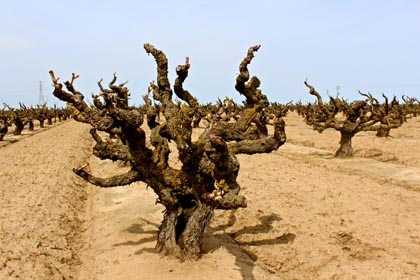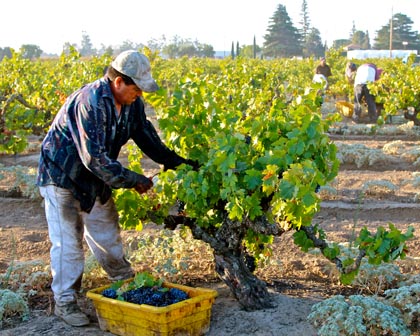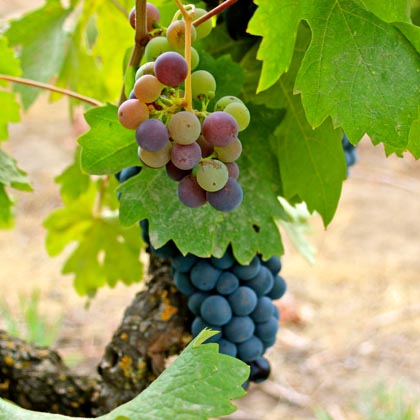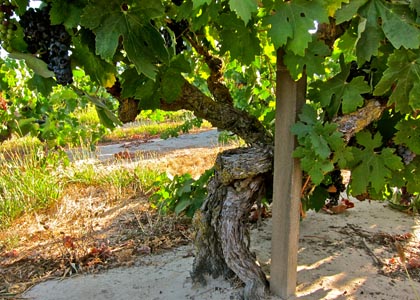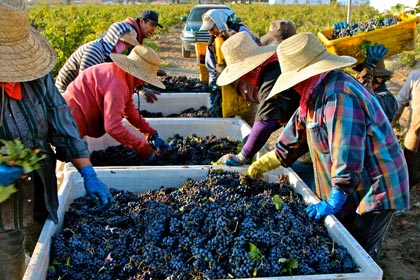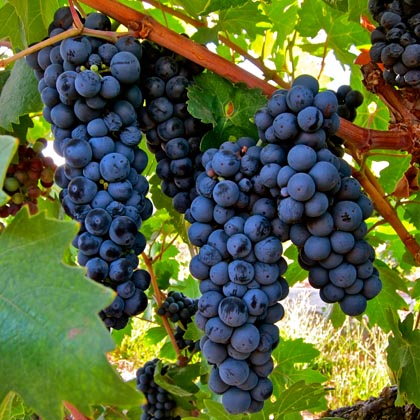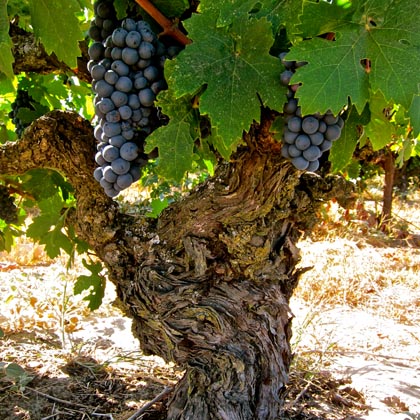Letters from Lodi
An insightful and objective look at viticulture and winemaking from the Lodi
Appellation and the growers and vintners behind these crafts. Told from the
perspective of multi-award winning wine journalist, Randy Caparoso.
Lodi Zinfandel’s transitioning styles & unbeatable food-moxie
Classic old vine Zinfandel: Soucie Vineyard, planted in 1916 in the super-sandy loam soil of Lodi's Mokelumne River AVA
This is the first of three consecutive parts of an autumn paen to Zinfandel. That is, Lodi‘s special Zinfandels…
Not too long ago, when people said “Zinfandel,” they usually meant something pink and sweet. But those days are gone; and aside from Woodbridge by Robert Mondavi, virtually no winery in Lodi makes a (now) old fashioned, fruity White Zinfandel. Zinfandel is back to being a red wine, period.
The styles of Zinfandel, however, have undergone a few transitions since the White Zinfandel craze. Before Zinfandel became pink, varietal bottlings of red Zinfandel tended to be fairly light, soft in tannin, and fairly zesty with prickly acidity. 13% alcohol was considered “big,” and the grape was associated with traditional producers of the day, like Louis Martini and Sebastiani.
There was always plenty of Zinfandel grown in Lodi – more than in any other part of the state – but almost all of it ended up in jug wine blends like E. & J. Gallo’s Hearty Burgundy. Longtime Lodi grower Jonathan Wetmore has told us, “In the seventies, harvest never started until after Labor Day, and only because that was when Gallo opened its doors to receive grapes. There was no Cabernet Sauvignon, Merlot, or Sauvignon blanc to deliver – those varieties didn’t exist in Lodi at that time. It was primarily Zinfandel for wine, and the seeded table grape, Tokay, was the premier grape in Lodi.”
2012 picking of Lodi's 100+ year old Noma Vineyard Zinfandel
What didn’t go to big wineries like Gallo was usually packed up and sent back East to home winemakers. Says Wetmore, “the idea of picking Zinfandel ‘for flavor’ wasn’t in the picture. We never picked Zinfandel until the 20th of September, and a lot of it had to be done by the week before Columbus Day in October, because that was when the Italians on the East Coast traditionally made their wine, and we’d need at least a week to get the grapes over to them by rail.”
Interestingly enough, today there is still plenty of Zinfandel – as well as other grapes, like Merlot, Petite Sirah and Carignan – packed up in half-ton boxes with dry ice, and even in 30-lb. wood lug boxes, and sent back East in refrigerated trucks. Half-ton shipping is still a big part of Borra Vineyards’ business – dwarfing, in fact, their own premium wine production.
When did California Zinfandel start to become associated with ultra-ripe, oaky, high octane styles of red wine – usually made from grapes picked deeper into October at sugars as high as 27° to 30° Brix (in the “old days,” 24° was considered excessive), and as a consequence ending up with alcohols closer to 15%-16% alcohol or more (even when lightened with water)?
You could, perhaps, point to the organization of ZAP, the Zinfandel Advocates & Producers: a consortium of wineries and enthusiast formed in 1991 to “elevate the status and understanding of Zinfandel wine” (according to the ZAP Web site). Within a few years, as many as 10,000 Zinfandel lovers were flocking to ZAP’s annual Grand Tasting in San Francisco, which has since grown into a week-long affair.
It’s not like ZAP caused Zinfandels to become bigger and brawnier: the stylistic shift had more to do with the residuals of wineries collectively trying to “outzin” each other, especially when gathered under one gargantuan tent. Zinfandel lovers, voting with their pocketbooks, quickly became enamoured by the exaggerated styles – for good or bad, ZAP has played its part.
First and second crop Zinfandel in Harney Lane's Lizzy James Vineyard (planted in 1904)
Certainly, top-flight Zinfandel producers like Ridge, Ravenswood and Rosenblum had been producing super-sized Zinfandels for years, long before the formation of ZAP (in fact, the “three Rs” were, and remain, among the original proponents of ZAP). Between both the 100 point score-keeping critics and the consumers themselves, the bigger-the-better Zinfandels became the standard bearers. Lighter, zestier 12%-13% alcohol Zinfandels just sort of withered away; and today, a lighter, “elegant” style of Zinfandel still tops 14% alcohol – a far cry from the 12%-13% styles of the sixties and seventies. But as Ravenswood’s famous mantra, “no wimpy wines,” implies: if you can’t stand the heat, get out of the kitchen.
But even in Lodi, there were wineries that never joined that bandwagon. The Lucas Winery, started up by winemaker/proprietor David Lucas in 1978, has persevered through the decades: their style has remained stubbornly old school-ish – hovering in the 14% alcohol range, while avoiding big, low acid, jammy-sweet qualities more typical of Zinfandels today.
Michael and David Phillips founded Michael David Winery in 1984 (called Phillips Vineyards up until 2000), but their moderately scaled, soft and spicy fruit-forward 7 Deadly Zins didn’t really start to explode in the national market until ten years ago; while their more limited, flamboyantly rich Earthquake and Lust bottlings have definitely been geared more towards consumers who prefer the gigantic, oaky style of Zinfandel.
In fact, most of the leading Zinfandel specialists in Lodi today began to make their mark only during the past decade. In recent vintages, producers like Macchia, m2, Klinker Brick and Jessie’s Grove have flirted with bigger, ultra-intense styles: Zinfandels finished in the 15%-16% alcohol range, and as compelling as any produced in California
Other Lodi producers – like Borra, Heritage Oak, Peirano, LangeTwins Family, McCay, Maley Brothers, Barsetti, and most recently, Stellina and Twisted Roots – seem to focus on more moderately weighted styles reminiscent of (although not quite) older days: Zinfandels running on the lower side of 14% alcohol, usually with softer tannins and a little less emphasis on oak.
Mohr-Fry Ranches' Marian's block (planted 1901)
Still others – like St. Amant, Mettler Family, Van Ruiten Family, Harney Lane, Fields Family, Ironstone, and DFV (under their Brazin and Gnarly Head labels) – have hovered somewhere in between: Zinfandels finished closer to 14.5% to 15.5% alcohol, with perceptive oak, while not trying to be overbearing
Ultimately, no Zinfandel can or should be judged based upon alcohol alone. A 16% Macchia or m2, for instance, is often sleeker and more finely balanced than most Zinfandels in the 14% alcohol range: complexity and sheer intensity of fruit will do that, when a Zinfandel is well made. Macchia winemaker/owner Tim Holdener tells us, “We never set out to make a 16% alcohol wine, but one of the advantages of being a small producer in the same region is that we can pick when flavors are optimal and the pH is in balance… and so if the alcohol happens to end up at 15% or at 16.5% within that optimal window, that’s the way it ends up.”
Zinfandel’s holiday food-moxie
If anything, a good Zinfandel proves its ultimate mettle at the table, when served with food. The zesty qualities of lighter, old school Zinfandels have always made terrific matches with anything from simple plates of spaghetti in tomato sauce to good ol’ American barbecues, slathered in the stickiest, sweetest, spiciest, zestiest sauces.
2012 Zinfandel harvest in Noma Vineyard
In that sense, few wines have nearly the food-moxie as Zinfandel: it is precisely the fruity, peppery spiced, zesty, and full bodied characteristics typically found in a good Zinfandel that makes it go so well with the spicy, zesty, intensely flavorful foods we actually love to eat. Even aggressively smoky-oaked Zinfandels have the advantage over other reds with wood grilled foods dolled up in spices and sauces that overwhelm wines like Pinot Noir, or fight the tannins of Cabernet Sauvignon.
Marian's Vineyard Zinfandel
Ditto for slices of beef or pork steeped in Asian components like soy sauce, palm sugar, sesame, garlic and ginger; meaty salads of slightly bitter mesclun in winey balsamic vinaigrettes; red fleshed fish finished with bacon, lardons or veal stock laced sauces; or any dishes incorporating sausages from chorizo to linguisa: the versatility of Zinfandel is practically unmatched in today’s culinary world.
Finally, if there ever is a time when food versatile reds are most welcome, it’s during the holidays when the entire gamut of food sensations – sweet, sour, salty, bitter, spicy, and the savory, often earthy taste of umami – are typically found on the table, often ending up on one plate.
Thanksgiving is the first major challenge, when sweet/sour cranberry is juxtaposed against the bland meat of turkey, stuffed with any manner of dressing: classic, sage laced cubes of bread; pungent herbs with orzo pasta and pear; croutons with pungent mushrooms, onions and celery; wild rice with pecans, mushrooms or chopped giblets; cornbread with chopped chiles, or else ham hocks or collards; sourdough with smoked meats and leafy green herbs; Italian sausages with shavings of Parmigiano; oysters with butter, onions and parsley… multiplicities of sensations that demand a wine that is both full bodied and fruit driven, preferably with perceptible spice, slivers of oak, a modicum of acidity, and firm yet unobtrusive tannins. In other words: Thanksgiving is Zinfandel time…
As is the month of December, when foods get even richer and earthier – be it roasted goose, smoked hams, grilled venison, the smell of baking pies of fruits, meats or mincemeat pervasive in the air: when those nostril tingling holiday dishes are laid out on the table, never, never underestimate the culinary value of Zinfandel — especially one crafted in the friendly style of Lodi!
Next week, part 2 of our autumn paen to Zinfandel: East side, west side, Lodi Zinfandels getting around the block
Kirschenmann Vineyard Zinfandel (planted 1915)
